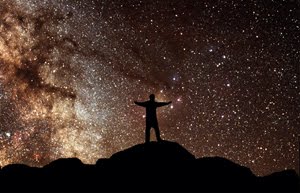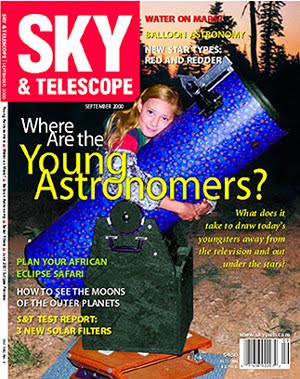It was quite a night at Coe on Saturday. I knew it could be, as the morning cloud cover seemed the perfect summer pattern, a low marine layer settling in over the valleys of the south bay... covering San Jose, Morgan Hill, Gilroy and Hollister. And that's how it turned out. What a night!
I arrived at Henry Coe State Park at 5pm, finding Rashad Al-Mansour parked at the top of the lost and Jim Collins at the south end of the lot. That's where I usually like to set up, since it has a nice unobstructed view to the south and east. However, knowing my targets for the night were primarily in Virgo and Hydra, which would be transiting the south, I parked up high in the lot to get the famous south-end-of-the-lot oak tree out of my way. It worked wonderfully. On one side of me was Richard Navarrete with his 18" Obsession, on the other, Pete Santangeli using a wonderfully designed piece of wood-art with 16" optics on an AP 900 mount. Others who made it up were Rich Neuschaefer, Guillermo Ortiz, Greg LaFlamme, Kevin Roberts, Bob Havner, Alan Zaza, Mike Delaney, another Mike who's last name will come back after I finish this report, and several others who arrived at or after dark. It was an excellent crew, a nice mix of newcomer enthusiasm and grizzled experience.
I want to mention the rides, up and back. It is part of the fun. It was a treat. The hills could not be greener. The lake is high to the point that there are lots of trees *in* it. Wildflowers, deer, and numerous types of birds created an idyllic scene, making the drive relaxing and fun. I took my time and soaked it in. This morning, I awoke to fog in the valleys, civilization did not exist except for under the white blanket. On the way down, quail and jays launched from trees as my truck approached, and fog was dripping off the Spanish Moss on the old oaks. The fog was thick enough to require turning on my headlights and thinking about my wipers.
So, you can imagine what it was like. San Jose and the south bay seemed to pretty much disappear during the night.
Now this was a good night in terms of dark, I'm not so sure about the transparency. I heard some of the regular Coyotistas realizing that elevation matters, and that Coe is quite a good site. The fog helped shape those remarks, I'm sure, but I know Coe in comparison to Coyote is a winner. Other than the surface. There was some dust at Coe, but this is an outdoor activity, and surely, last night, a good one, Coyote would have been under the blanket. I'll keep going to Coe.
During the night Kevin and Greg came by asking about limiting mag. I suppose it was a result of Jamie Dillon phoning us from Fremont Peak, talking about mag 6 skies. I'd brought my Finnish Triangles charts along and we decided to do a star count in Virgo (chart 10). Here is a link:
Kevin and I were getting between 18 and 20 stars over multiple counts. Greg was surprised at not getting as many, but people's eyes vary. You find out in this hobby. Even those with really good vision can be surprised by others with experience and really good night vision. With some practice, Greg found he was seeing many more stars than he originally thought. So, we were getting down to mag 6.8 - 7.0 with averted vision.
Yes, it was dark at Coe last night.
Of the objects I observed, I've been observing the Herschel Catalog for several years. There are over 2500 objects on it. I'm down to a few hundred remaining. They've been difficult to get to, as they are all in spring skies, and we've had terrible springs for observing for probably the last five years. I was surprised to look in my log book and see dates back to.... oh... unreal.... back to 1996.
Last night I logged 51 new objects. Many were quite dim, even though I could count naked eye stars to around mag 7, in the eyepiece it was another matter. Objects required some real work to pull in the dim ones. Fortunately, there were others that were bright (relatively speaking), so my pace was good. I didn't take many notes, unless something seemed worth remembering. Sometimes just hunting and finding is the fun.
Some of the fields were quite good....
NGC 4933 is three galaxies right on top of each other. There are A, B and C components. I did not break them apart, but I picked up IC 4134, which according to NED is the same as NGC 4920. This was a very dim galaxy, according to The Sky (mag 14.15 in NED). Curiously, The Sky shows NGC 4920 nearby, but in a completely different location then IC 4134. The Sky says mag 16+ for the IC.
NGC 3822 was the brightest in a group of seven galaxies in one eyepiece field.
NGC 4299 is in a field of some nice big galaxies. Fun area. I also noticed on my computer a large planetary in the area, PLN 275+72.1 - Pete was imaging it. I think it may be a good imaging but not visual target.
NGC 4343 is also in the area of some big bright galaxies, interspersed with dimmer edge-ons and small challenge targets.
NGC 4413 and several others on the list turned out to be dimmer galaxies in and around Markarian's Chain, so this was a fun diversion.
NGC 4464 was next to M49, and two other bright galaxies. Fun, again, to see some Big Bright Object (BBO) next to the target. Nice detail!
NGC 4476 and other dimmies were next to M87. One of these times I'll look for the M's relativistic jet.
NGC 4496B was fun to see with the larger A component, and a few brighter galaxies around the edge of the field.
NGC 4517A is a nice large edge-on, but the B component is surprisingly far from it and much more difficult to pick out.
During the night, the breeze stayed well down, at least for the visual observers, the early dew dropped so things dried out nicely, and an inversion set in, raising temps as the night wore on.
What I came away with from my time hunting galaxies mostly in Virgo is, there is still a lot to look at. And, there are still surprises.
I can't wait for next month, my observing conditions forecast is for that great fog to return, improved transparency, and more observers finding out what an excellent site Henry Coe can be.
Those who were there, it was a great way to open a new observing season. See you next month!











